Website owner: James Miller
Fourier integral, transform. Magnitude and phase spectrum. Theorems. Impulse, rectangle, triangle, Heaviside unit step, sign functions. Convolution. Correlation, autocorrelation.
The Fourier integral. Let f (t) satisfy the Dirichlet conditions
(a) it is continuous except for a finite number of discontinuities
(b) it has only a finite number of maxima and minima.
on any finite interval
and assume that the integral
![]()
exists. Then Fourier’s integral theorem states that
![]()
(This is the complex, exponential form of the Fourier integral.)
Fourier transform. If we define
![]()
equation 1) becomes

The functions f (t) and F(ω) are called a Fourier transform pair. F(ω) is the Fourier transform of f (t) and f (t) is the inverse Fourier transform of F(ω). A sufficient condition for the existence of the Fourier transform F(ω) is that
![]()
i.e. that the integral exists. This condition is not a necessary condition, however, as functions exist which don’t meet the condition but do have Fourier transforms.
Theorem 1. If f(t) is real, then Fourier’s Integral Theorem states
![]()
Magnitude spectrum and phase spectrum of a function f(t). Let F(ω) be the Fourier transform of a function f (t). The function F(ω) is, in general, complex. Let us write it as
5) F(ω) = R(ω) + i X(ω) = |F(ω)| e i φ(ω)
where |F(ω)| is called the magnitude spectrum of f (t) and φ(ω) is called the phase spectrum of f (t). Since for any complex number x + iy, x + iy = reiθ, the magnitude spectrum is given by
![]()
and the phase spectrum is given by
![]()
General Fourier transform theorems
Theorem 2. If f (t) is real, then the real and imaginary parts of the Fourier transform F(ω) of f(t) are

and
10) R(ω) = R(-ω)
11) X(ω) = -X(-ω)
12) F(-ω) = F*(ω)
where F*(ω) denotes the complex conjugate of F(ω).
From 10) and 11), we see that R(ω) and X(ω) are even and odd functions of ω, respectively.
From Theorem 2, we conclude:
Theorem 3. If f (t) is real, the Fourier transform F(ω) of f(t) is
![]()
where the real portion of F(ω) is an even function and the imaginary portion is an odd function.
Theorem 4. If F(ω) is the Fourier transform of f (t),
F(-ω) = F*(ω)
is a necessary and sufficient condition for f (t) to be real.
Theorem 5. Let F(ω) be the Fourier transform of f (t). If f (t) is real, its magnitude spectrum |F(ω)| is an even function of ω and its phase spectrum φ(ω) is an odd function of ω.
Theorem 6. If the Fourier transform of a real function f (t) is real, then f (t) is an even function of t, and if the Fourier transform of a real function f (t) is pure imaginary, then f (t) is an odd function of t.
Fourier sine and cosine transforms
Theorem 6. If f (t) is given only for 0 < t < ∞, f (t) can be represented by
![]()
where FC(ω) is the Fourier cosine transform of f (t)
![]()
Procedure. If f (t) is given only for 0 < t < ∞, we can define f (t) for negative t by the equation f (-t) = f (t), so the resulting function is even. We may then utilize the Fourier cosine transform and its inverse to represent the function. In interpreting results we must, of course, remember that f (t) is defined only for t greater than zero.
Theorem 7. If f (t) is given only for 0 < t < ∞, f (t) can be represented by
![]()
where FS(ω) is the Fourier sine transform of f (t)
![]()
Procedure. If f (t) is given only for 0 < t < ∞, we can define f (t) for negative t by the equation f (-t) = -f (t), so the resulting function is odd. We may then utilize the Fourier sine transform and its inverse to represent the function. In interpreting results we must, of course, remember that f (t) is defined only for t greater than zero.
Another form of the Fourier integral and Fourier transform
Let us make the substitution
ω = 2πs
into equation 1) above where ω represents angular velocity and s represents frequency. With this substitution, the Fourier integral theorem becomes

Let us now define the Fourier transform as
![]()
and 18) becomes
![]()
where F(s) and f(t) constitute a Fourier transform pair.
Fourier transform theorems
Following is a concise summary of important Fourier transform theorems.
Fourier transform. The Fourier transform of the function f(x) is F(s). We can write F[f(x)] = F(s) and F-1[F(s)]= f(x).

and

Theorem f (x) F(s)
_____________________________________________________________________________
Linearity a g(x) + b h(x) a G(x) + b H(x)
(a and b constants)
Similarity f (ax)

Shift f(x-a) F(s)e-i2πas
Modulation f(x)cos ωx ½ F(s-[ω/2π]) +½ F(s+[ω/2π])
Convolution f(x)*g(x) F(s)G(s)
Autocorrelation f(x)*[f*(-x)] |F(s)|2
Derivative f’(x) i2πsF(s)
(providing f(x) →0 as x → + ∞)
_____________________________________________________________________________
Derivative of convolution
![]()
Rayleigh
![]()
Power
![]()
(f and g real)
![]()
_____________________________________________________________________________
Special functions. There are a number of special functions that are widely used in Fourier analysis. The most important ones with definitions and graphs are shown in Tables 1 and 2 below.
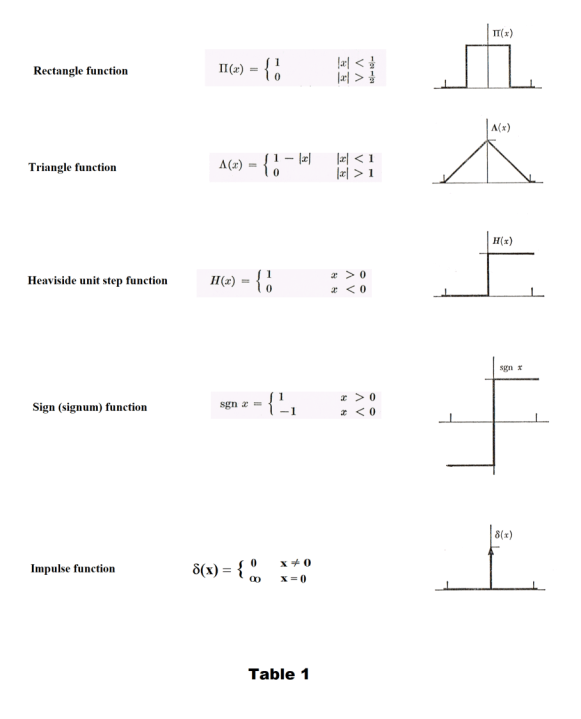
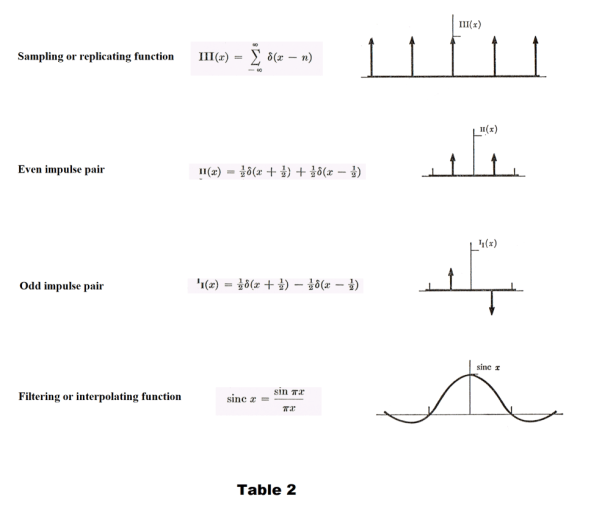
Def. Rectangle function. A function [see Fig. 1 (a)] of unit height and unit base length defined by

This function is used to select segments of some particular function, masking out the rest. For example, the function f(x) = II(x) cos x selects and displays the portion of the cos x function in the interval [-½, ½] and masks out the rest as shown in Fig.1 (b), providing a compact notation for
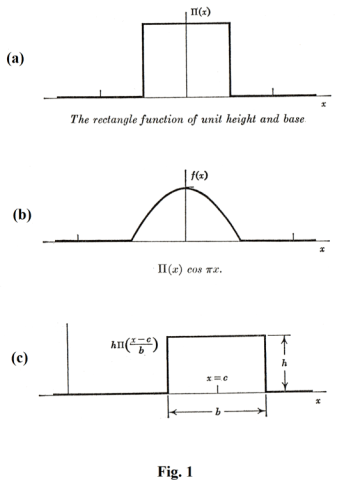

It should be noted that hII[(x - c)/b] is a displaced rectangle function of height h and base b, centered at x = c. See Fig 1 (c). Using a suitably displaced rectangle function one can select any segment of a given function, masking out the rest (i.e. reducing it to zero).
Def. Triangle function. A function defined by

See Fig. 2. Note that h∧(x/½b) is a triangle function of height h, base b, and area ½hb. The main importance of the triangle function derives from it being the self-convolution of II(x).
Def. Heaviside’s unit step function. A function defined by
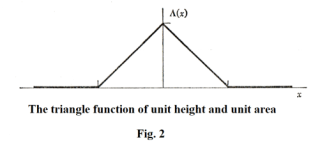

See Fig. 3 (a). As with the rectangle function, the Heaviside unit step function is used to select segments of some function, masking out the rest. The rectangle function II(x) can be expressed in terms of step functions as
25) II(x) = H(x + ½) - H(x - ½)
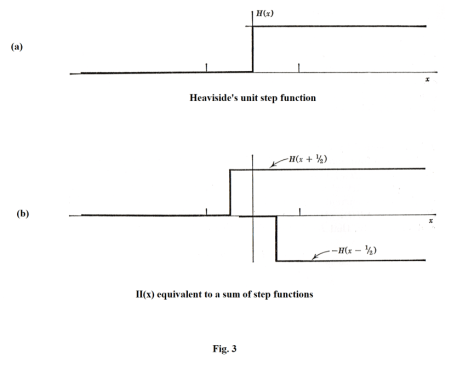
See Fig. 3(b).
Def. Sign function. The function sgn x (pronounced signum x) is equal to +1 or -1 , according to the sign of x.
![]()
Def. Impulse function (also called Delta function). The impulse function δ(x) (which is not actually a function in the usual sense of the word) has the following two properties:

It can be defined as:
![]()
The τ-1II(x/τ) product represents a rectangle function of height 1/τ and base τ and with unit area. As τ approaches zero a sequence of unit-area pulses of ever-increasing height are generated. The limit of the integral is, of course, equal to 1.
Fourier transform of functions built up from rectangle functions
If

it can be shown that its transform is given by
29) F(s) = ace-2πbs sinc cs
If now we have a function built up from a sequence of rectangle functions
![]()
the transform is given by
![]()
Such functions occur frequently in engineering and can simulate, as closely as desired, any kind of variation.
Convolution of two functions. The convolution of two functions f (x) and g(x) is defined as
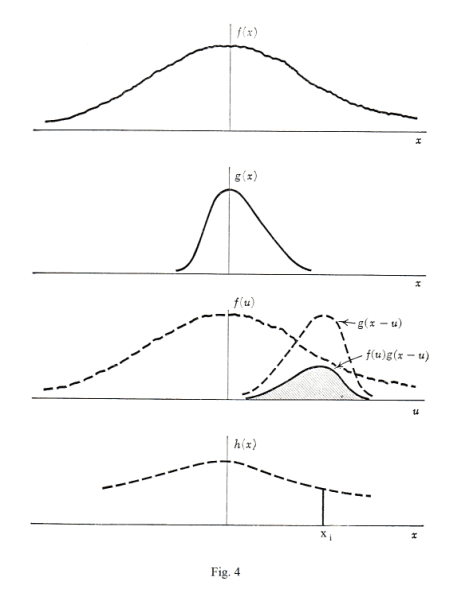
![]()
and denoted by f *g.
Syn. bilateral convolution
The convolution of two functions occurs widely in mathematics, science and engineering in many contexts and under various names (including the German term Faltung). One place where it occurs is in connection with data smoothing. An example involving data smoothing is shown in Fig. 4 where f(x), g(x), and h(x) are shown. The functions g(x-u) and f(u)g(x-u) are shown for one particular value of x, x= xi. h(xi) represents the area under f(u)g(xi-u).
Fig. 5 shows the reason for the German term Faltung (which means “folded back”) for the convolution operation. Here g(u) is shown folded back on itself about the line u = ½x to give g(x-u). For each value of x= xi there is a function g(xi-u) that can be obtained by a fold at u = ½x — along with the function f(u)g(xi-u). h(xi) represents the area under f(u)g(xi-u).
The Convolution theorem. The Fourier transform of the convolution of f and g is the product of the Fourier transforms of f and g i.e.
32) F (f *g) =F (f ) F(g)
Theorem 8. Convolution obeys the commutative law.
33) f(t)*g(t) = g(t)*f(t)
Theorem 9. Convolution obeys the associative law.
34) [f1(t)*f2(t)]*f3(t) = f1(t)*[f2(t)*f3(t)]
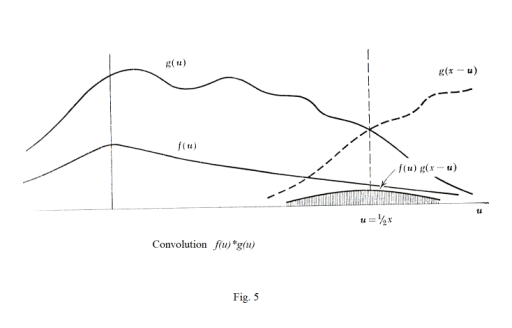
Theorem 10. The convolution of a function f(t) with a unit impulse function δ(t) yields the function f(t) itself.
35) f(t)*δ(t) = f(t)
Theorem 11. The following relationships hold:
36) f(t)*δ(t - T) = f(t - T)
37) f(t - t1)*δ(t - t2) = f(t - t1 - t2)
Correlation functions. In signal processing, the functions
![]()
and
![]()
(where f1(t) and f2(t) are real-valued functions) are known as cross-correlation functions. They represent a measure of the similarity between the two functions f1(t) and f2(t) as a function of the shift of one function relative to the other. If the cross-correlation function is identically zero for all τ, the two functions are said to be uncorrelated. They are commonly used for searching a long signal for a shorter, known feature. If f1(t) and f2(t) are identical, the correlation function
![]()
is called the autocorrelation of f1(t). In Fig. 6. the shaded area under the curve f(u)f(u - x) represents the autocorrelation
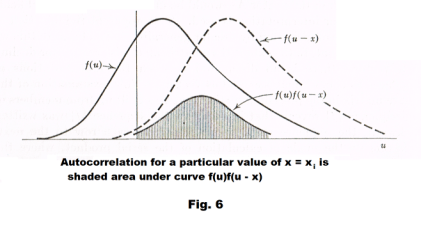
![]()
for a particular value of x, x = xi.
Note. The cross-correlation integral is similar to the convolution integral but has different properties. For example, in the case of convolution f1* f2 = f2*f1, whereas with cross-correlation this is not the case. When the functions are complex it is customary to define the complex cross-correlation function by
![]()
where the * denotes the conjugate.
By making a change of variable from t to t + τ, it can be readily seen that
![]()
![]()
![]()
Theorem 12. The following relationships hold:
44) R12(τ) = R21(-τ)
45) R11(τ) = R11(-τ)
Equation 45) states that the autocorrelation function is an even function of τ.
Theorem 13. If F[f1(t)] = F1[(s)] and F[f2(t)] = F2[(s)], then
46) F[R12(τ)] = F1[(s)] F2[(-s)]
47) F[R21(τ)] = F1[(-s)] F2[(s)]
48) F[R11(τ)] = F1[(s)] F1[(-s)]
49) F[R11(τ)] = |F1[(s)]|2 if f1(t) is real
From 49) we see that the Fourier transform of the autocorrelation function R11(τ) yields the energy spectrum |F1[(s)]|2 . Thus the autocorrelation function R11(τ) and the energy spectral density |F1[(s)]|2 constitute a Fourier transform pair.
If f(t) is complex it is customary to define the complex autocorrelation of f(t) as
![]()
where the * denotes the conjugate.
References
Hsu. Fourier Analysis
Bracewell. The Fourier Transform and Its Applications
James, James. Mathematics Dictionary
Spiegal. Laplace Transforms. (Schaum) Chap. 6
Wikipedia
Jesus Christ and His Teachings
Way of enlightenment, wisdom, and understanding
America, a corrupt, depraved, shameless country
On integrity and the lack of it
The test of a person's Christianity is what he is
Ninety five percent of the problems that most people have come from personal foolishness
Liberalism, socialism and the modern welfare state
The desire to harm, a motivation for conduct
On Self-sufficient Country Living, Homesteading
Topically Arranged Proverbs, Precepts, Quotations. Common Sayings. Poor Richard's Almanac.
Theory on the Formation of Character
People are like radio tuners --- they pick out and listen to one wavelength and ignore the rest
Cause of Character Traits --- According to Aristotle
We are what we eat --- living under the discipline of a diet
Avoiding problems and trouble in life
Role of habit in formation of character
Personal attributes of the true Christian
What determines a person's character?
Love of God and love of virtue are closely united
Intellectual disparities among people and the power in good habits
Tools of Satan. Tactics and Tricks used by the Devil.
The Natural Way -- The Unnatural Way
Wisdom, Reason and Virtue are closely related
Knowledge is one thing, wisdom is another
My views on Christianity in America
The most important thing in life is understanding
We are all examples --- for good or for bad
Television --- spiritual poison
The Prime Mover that decides "What We Are"
Where do our outlooks, attitudes and values come from?
Sin is serious business. The punishment for it is real. Hell is real.
Self-imposed discipline and regimentation
Achieving happiness in life --- a matter of the right strategies
Self-control, self-restraint, self-discipline basic to so much in life